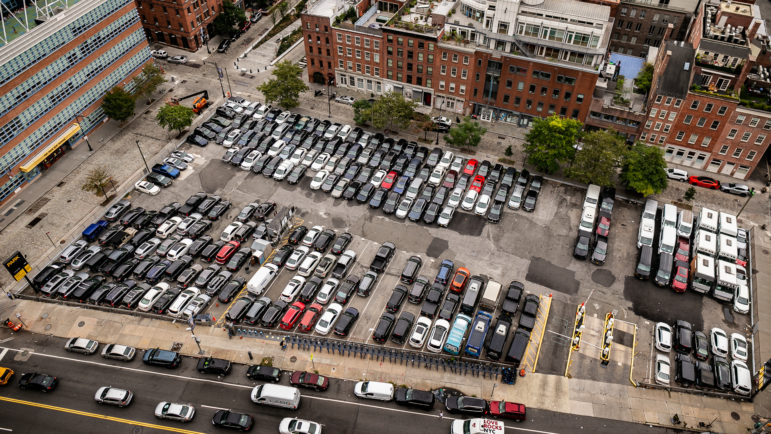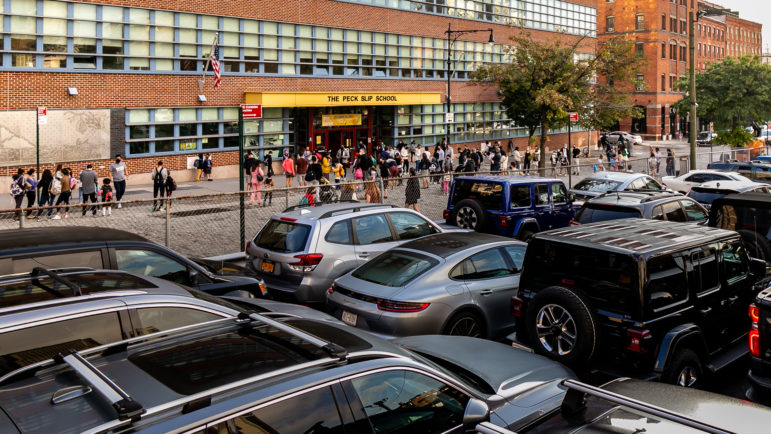The lot where the project is being planned, just feet away from two elementary schools, once was the site of a thermometer factory.

Adi Talwar
Parents with children in the Peck Slip School and the Blue School, (left to right) Megan Malvern, Grace Lee with her 3 year old daughter Lenny, Emily Hellstrom and Colleen Robertson standing on a cobblestone street near the former thermometer factory site.
With schools back in session this year, the narrow streets in front of the Peck Slip School and the Blue School at the South Street Seaport are once again bustling with activity. Aside from the masks, the scene is much as it was pre-pandemic: each weekday morning, kids as young as 2 dart across the cobblestone to meet friends while parents make small talk over dogs and strollers.
But in recent months, the conversation among those parents has centered around concern for their children’s safety, as the start date for a long-awaited construction project nears.
The two schools — which combined serve kids from age 2 to 8th grade — sit on perpendicular streets abutting a nearly 48,000-square-foot parking lot that can accommodate 400 vehicles. Deep underneath the asphalt are levels of elemental mercury, an odorless neurotoxin that can be devastating to children’s health, and other potentially dangerous pollutants that date back centuries.
In the mid-1800s to 1900s, the site was home to a thermometer factory. It also held factories that produced boilers and radiators, an oil company and a gas station, among other businesses. Since then, the site has been sealed over, trapping mercury-contaminated soil and a fuel tank under the ground.
Next year, though, construction is set to begin on the site, where developer Howard Hughes Corporation plans to erect a 324-foot mixed-use building. The new building will be more than 140 feet lower than the developer previously proposed — an accommodation made to appease residents — but still nearly triple the height limit in the historic district. It is expected to include at least 70 units of affordable housing.
Residents of the neighborhood, located in Manhattan Community Board 1, have taken issue with several aspects of the project, including the character and the height of the building, which will tower over the historic district’s skyline. Those opposed include Save Our Seaport, an organization that formed about a decade ago to help revitalize and preserve the area’s maritime history, including the South Street Seaport Museum.
But a group of local parents are more concerned about the safety protocol during the removal of mercury and other pollutants, a process called a brownfield cleanup. The cobblestone street running along the perimeter of the lot serves as the children’s playground, and is just feet away from where their kids sit in classrooms or nap during the day, with windows open due to the COVID-19 pandemic. They’re asking the developer to wait until school is out to start the remediation of the site — and to take extra safety and monitoring precautions during the process.
The project has continued to move forward as planned, so in 2019, concerned parents formed their own coalition, Children First. Those in the group — moms with backgrounds in politics, community organizing and science education — are harnessing their skill sets to fight for transparency over how the process of cleaning up mercury and other pollutants at the site is handled.
Maggie Dallal, a Children First member and former high school science and chemistry teacher, helps educate the other parents on the technical information in the hundreds of pages of documents that the developer was required to submit to the state’s Department of Environmental Conservation as part of the brownfield cleanup process. During an early meeting about the project, she questioned a representative with Langan — the environmental consulting firm that is working with Howard Hughes on the cleanup — about how the site will be tented to prevent accidental contamination of the air near the schools.
The plan to cover the area with fabric barriers and sprinklers to keep dust down was not acceptable to her, she said. “I was expecting some Jetsons-like fancy futuristic bubble they put over it,” she told City Limits. “I started freaking out.”

Adi Talwar
The parking lot at 250 Water St. that Howard Hughes is planning to develop.History of failed development
Developers have had their eyes set on this site since the 1970s, when luxury developer Milstein Properties purchased it but failed many attempts to gain city approvals — or for that matter, community acceptance — of their plans, with the exception of one proposal in 1991 that was greenlit by the city’s Landmarks Preservation Commission (LPC) but never built, according to the Seaport Coalition.* Howard Hughes purchased the lot at 250 Water St. in 2018 for $180 million and has likewise faced community opposition, resulting in the company revising its plans several times.
In 2019, the lot was accepted into New York’s Brownfield Cleanup Program, through which a private party undertakes the remediation of a site with known contaminants under the supervision of the DEC and the Department of Health.
After the cleanup, the company plans to build a tower that is lower than originally proposed but about 200 feet above the height limit for the lot. In May, the developer got approval from the LPC to move forward with the project. In order to build to the full 324 feet, Howard Hughes Corporation will pay the city to transfer air rights from neighboring properties, Pier 17 and the Tin Building.
It has proposed allocating that money, as much as $50 million, towards the South Street Seaport Museum, which has long struggled with economic difficulties (exactly how Howard Hughes will transfer those funds has been the subject of complex negotiations between the developer and the city, The Real Deal reported in September; Manhattan Brewer President Gale Brewer has said her support of the project hinges on that money going to the museum.)*
The Seaport Coalition and other residents attempted to sue to overturn the LPC decision, but last month, a judge dismissed the case, though the Coalition told Crain’s that it plans to legally challenge the project once again, when the LPC issues the final Certificate of Appropriateness for the proposal.*
A representative with Howard Hughes told City Limits that the company is “committed to the safe and thorough cleanup” of the site, alongside the state agencies.
“Throughout that process, we will work closely with the Peck Slip and Blue schools to minimize any impact to operations and ensure a safe learning environment,” the representative said.
“More broadly, we are hopeful that our neighbors will embrace the opportunity to welcome 80 families earning around $45,000 to an area where the median household income is more than $150,000, all made possible through a safe and thorough cleanup and temporary construction period.”
The remediation of the site will happen in two steps, Langan associate Mimi Raygorodetsky said during a public meeting on Sept. 21. First, the company will go between four and 16 feet into the ground to remove mercury-contaminated soil. Then, there will be a site-wide excavation between 15 and 18 feet, she said. Also, the company will remove an underground fuel tank and remediate any impacted groundwater.
Raygorodetsky said during the meeting that the company was taking several steps to ensure mercury vapor does not escape the site, including the use of a suppression foam called Mercon-X. The company has used this product previously and can attest that it is effective, according to Langan.
Calls for extra scrutiny
Parents, though, are not convinced that the engineering firm, hired by the developer, has their community’s best interests at heart. They report being misled by the company before, citing a previous plan by Howard Hughes to convert the roof of the nearby Pier 17 into open green space. Instead, it became a 3,400-person concert venue.
“We remain committed to being thoughtful collaborators and responsible stewards of the community, creating programming that enhances the authentic vitality of the neighborhood and driving initiatives that support residents and local businesses in Lower Manhattan,” a spokesperson for Howard Hughes said in a statement.
To assuage their fears, the DEC and DOH agreed to collaborate with independent consultants hired by residents to review the process. And, parents said, their experts found discrepancies.
For instance, laboratory tests conducted at several spots in the factory footprint did not detect elemental mercury, a point that was emphasized by Langan associate Mimi Raygorodetsky at the September public meeting.
But further testing, during a standard investigation of the site, found levels of mercury under the sidewalk just outside the project site, and a handheld mercury device alerted to levels of mercury vapor at the holes where the tests were conducted, explained Keith Brodock, an engineer who specializes in brownfields and who was hired by the law firm representing the residents and organizations opposing the project.
“There were detections of mercury in the air from these really small holes in the ground,” said Brodock. “[During] the remediation where Langen and the developer are going to dig out and open up large holes in the ground, that could lead to higher concentrations or more mercury coming out of the ground because now there’s a larger surface area of soil exposed to air.”
Brodock said that the site warrants extra scrutiny because of the presence of elemental mercury. “Mercury vapor is not a common contaminant that would be dealt with on brownfield cleanup projects,” he said.
The developer’s draft remedial action plan says that there will be mercury air monitors along the perimeter of the site during the excavation of the hotspot — but after that is completed, the monitors may be removed. Brodock said he believes because mercury vapors were detected elsewhere on the site, the monitoring should continue through the entire mediation. “The highest field screen reading we saw was on the western portion of the site,” he said. “Totally outside of the mercury hotspot area.”
Langan told City Limits that the company has overseen the remediation of more than 40 sites in New York City through the Brownfield Cleanup Program since 2003 and that it is currently overseeing cleanups at at least 50 other sites.
The DEC said city agencies are working closely with the independent consultants. The agency also noted it conferred with an expert at the state’s DOH with extensive experience in mercury contamination.
Other complicating factors include the weather of the area — the Seaport, located at the bottom tip of Manhattan and just half a mile from the East River, is notoriously windy and is located in a flood zone. Also, the developer’s draft remedial work plan makes no mention of special circumstances during COVID-19 — the fact that nearby school windows remain open throughout the day for better classroom ventilation.
Brodock agrees the virus measures, like open windows, makes the project unique. “It’s not the standard time in which even I or, I think, anybody else is used to conducting remediation in the brownfield cleanup program,” he said.
A representative with Langan said the company will be monitoring the perimeter of the site to identify potential exposure. “The same rigorous mitigation and control measures will be implemented regardless of windows at adjacent buildings being open or closed,” the representative said.
A representative for the DEC told City Limits that the agency is committed to keeping the public engaged and informed throughout the process and has extended public comment periods and accommodated requests for meetings and other outreach “to foster an understanding of the ongoing work to clean up the contamination.”
“Measures are in place to ensure air quality, and other potential concerns are closely monitored to prevent any potential impacts to the surrounding community while work is underway,” the spokesperson said in a statement.
Grace Lee, cofounder of Children First and a former candidate for state Assembly, argues that the public comment period began just as school ended in June, and wasn’t enough time for parents to weed through the more than 400-page draft plan. The agency extended the public comment period twice but denied the parents’ request to extend it a third time, to mid-October.
Furthermore, Lee said she feels as though parents’ input is not being heard.
“As moms, as women trying to fight for our children, there were often times they tried to cast us as hysterical, too worried, and that’s, frankly, totally sexist, but also as a way to diminish real concerns about what’s going on,” she said.
“If you’re not taking us seriously, you’re not taking our kids seriously,” said Emily Hellstrom, co-president of the Peck Slip Parent Teachers Association.

‘It’s triggering’
Some residents of the Seaport area say their concern and mistrust of government officials harks back to 9/11, when then-U.S. Environmental Protection Agency Administrator Christine Todd Whitman announced that the air near Ground Zero was safe to breathe.
“This is a community told to come back to their homes after 9/11, told it was safe,” said Grace Lee. “We’ve been lied to before.”
In 2003, the EPA’s inspector general’s office found that the agency did not have the data to make that determination. The report also noted that George W. Bush’s White House “convinced EPA to add reassuring statements and delete cautionary ones.” Whitman later apologized.
More than 400,000 individuals were exposed to toxic air in the aftermath of the attacks. Twenty years later, surviving 9/11 responders are still suffering from health effects, including cancer and asthma, that can be linked to asbestos, benzene from jet fuel, and other pollutants.
Stacey Shub, another resident opposed to the Howard Hughes project, said she lived in the neighborhood on 9/11 and has neighbors who are on oxygen for chronic obstructive pulmonary disease and knows others with leukemia, or who have died. She recalls Whitman’s announcement and says it’s why she is hesitant to trust the developer for this project.
“I very clearly remember hearing those words and smelling what smelled like burning tires, and trying to reconcile that,” she said. “So when anyone comes in here and just says, ‘Oh… trust us, it’s safe, the air will be safe,’ we don’t believe it. And not only do we not believe it, it’s triggering. Very triggering.”
Langan said it will submit daily air monitoring reports to the state and those will be available on the project website.
The DEC says that the project is still in the “remedy decision document stage” and that the agency, along with the DOH will be reviewing all public comments and potentially request revisions to the company’s action plan. Final details about the cleanup will be included in the decision document issued by the DEC after this period.
The parents have gained the support of City Comptroller Scott Stringer, a former Peck Slip parent who has participated in protests against the project. “The existing plan for a new development on this contaminated site threatens the well-being of thousands of children, senior citizens and the whole Seaport community,” he told City Limits in a statement. “The current plan must be enhanced to protect our children’s safety and allow for the community’s concerns and needs to be voiced and addressed throughout the process.”
Dallal, the former science teacher, was so frustrated with the project — not only the brownfield cleanup, but also the expected ongoing construction, which she called a “double whammy” — that in June 2019, she moved her family, including children who were then 6 and 3, away from the Seaport.
“My son would spend most of his grade-school experience attending a school next to a construction site that could severely impact his learning and health. No thank you!” she said.
Colleen Robertson, a substitute teacher at the Blue School, said concerns about the project are trickling down to the children, too.
“It weighs so heavily on everyone,” she said, adding that her second-grade son is concerned and asking questions about the project.
She told him, “Grownups are taking care of it.”
Liz Donovan is a Report for America corps member.
*City Limits updated these lines after publication to clarify and expand on certain details.










One thought on “Parents and Developer Clash Over Mercury Cleanup Next to Seaport Schools”
Thank you Liz Donovan and City Limits for airing the very real concerns for the health and safety of our children as well as the seniors and residents of the Seaport Area. The City seems to feel it is of the utmost importance to get this project done at rapid speed at the cost of our health and welfare. This project needs to slow down and listen to the people this project will impact.